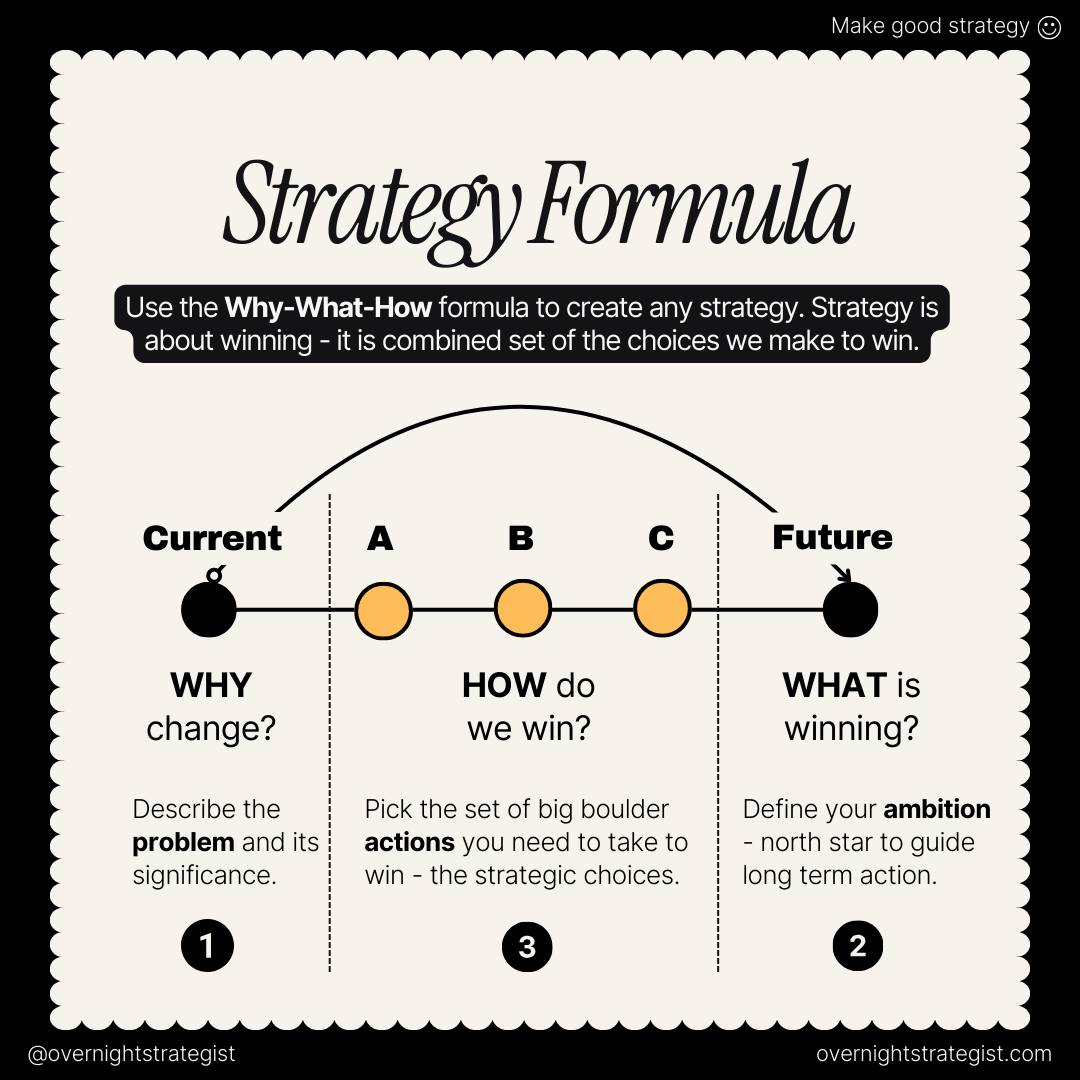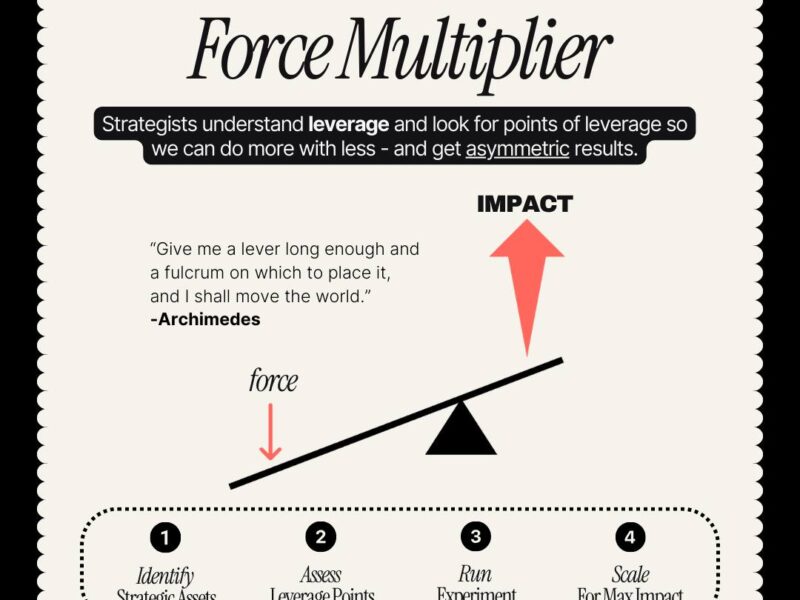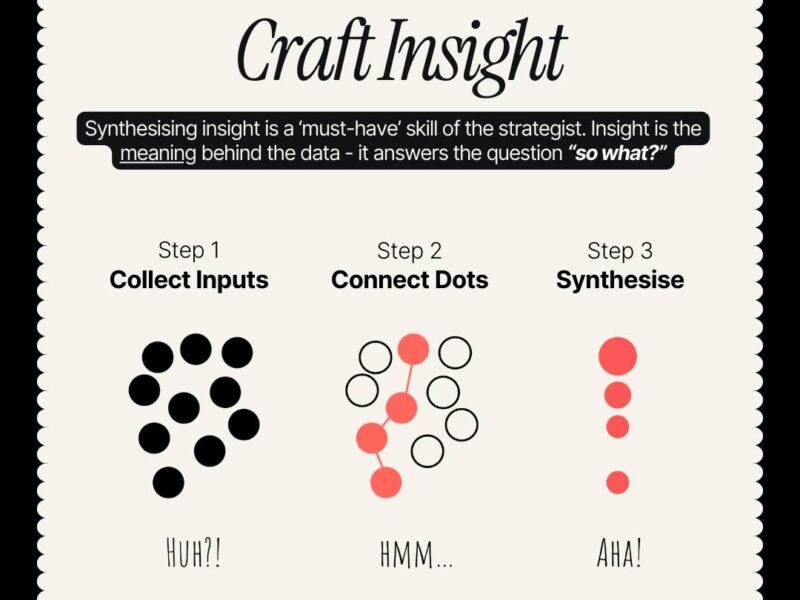A Practitioner’s Guide to Winning with Why, What, and How
For over two decades as a UX Designer and IT Solutions Architect, I’ve been in the trenches. I’ve seen countless projects launch, countless products ship, and—if I’m being honest—countless strategies fail. They fail not for a lack of effort, talent, or resources. They fail because the strategy itself was flawed from the outset.
A common scenario: a team rallies around a shiny new goal—”We need an AI-powered chatbot!” or “Let’s build a mobile app!” This is the what, the solution, presented without context. But why the chatbot? What problem is it solving? For whom? And how will it tangibly make the business win? Without clear answers, the project becomes a ship without a rudder, drifting aimlessly until it runs aground on the shores of wasted budget and team burnout.
The hard truth is this: most strategies fall flat because they miss the essential scaffolding that holds a winning plan together. They are a collection of actions without a unifying purpose or a defined finish line.
After 20 years of learning from these missteps, I’ve converged on a deceptively simple yet profoundly powerful framework: The Strategy Formula, or the Why-What-How model. This isn’t just another business buzzword; it’s the mental model I use to architect successful digital experiences and IT solutions. It’s a formula for winning.
The Anatomy of a Winning Strategy: Deconstructing the Formula
At its core, strategy is about winning. It’s the combined set of choices we make to achieve a desired future state. The Strategy Formula breaks this down into three fundamental, interdependent questions:
WHY do we need to change?
WHAT does winning look like?
HOW do we win?
The genius of this model lies not only in the questions themselves but in their sequence. Notice the numbering in the original diagram: it’s not 1-2-3, but 1 (Why), 3 (How), 2 (What). This is a critical insight. You start with Why, then jump to How, and only then do you crystallize the What. This forces you to consider the feasibility and cost of your actions (How) before you lock in an immutable, and potentially unrealistic, goal (What).
Let’s deconstruct each component in detail, viewing them through the dual lenses of UX design and technical architecture.
1. WHY: The Bedrock of Your Strategy and the Case for Change
Every enduring structure, whether a skyscraper or a software platform, is built on a solid foundation. In strategy, that foundation is your “Why.”
What it is: The “Why” is a clear, compelling, and evidence-based articulation of the problem you are solving and the reason change is necessary, urgent, and significant. It’s the burning platform. It answers the questions: Why now? Why us? What happens if we do nothing?
The Practitioner’s Deep Dive:
In UX, this is the domain of Problem Framing and User Research. We cannot design a solution for a problem we don’t understand. My teams spend a disproportionate amount of time here, because a well-defined problem is a half-solved problem.
Tools & Inputs:
User Interviews & Contextual Inquiry: Go beyond what users say; observe what they do. Uncover their latent needs and pain points. (Nielsen Norman Group: Contextual Inquiry)
Analytics & Data Analysis: Quantitative data from tools like Google Analytics, Mixpanel, or Pendo reveals the “what” (e.g., “a 70% drop-off on the payment page”), which the qualitative research must explain the “why.”
Competitive Analysis: Understand the landscape. What are others doing? Where are they succeeding or failing? (Strategyzer: The Value Proposition Canvas is excellent for this.)
Stakeholder Interviews: Understand business constraints, technical debt, and internal capabilities. The “Why” often involves internal operational pains, not just external user pains.
Heuristic Evaluation: A expert review of an existing product against established usability principles can quickly surface glaring “Why” issues. (Nielsen Norman Group: How to Conduct a Heuristic Evaluation)
Expected Output:
A crisp Problem Statement.
A Journey Map highlighting key pain points.
User Personas that ground the problem in real human archetypes.
A shared document, often a “Project Brief” or “Press Release” (a la Amazon), that encapsulates the “Why” for the entire team. (Amazon: Working Backwards)
Best Practice: Avoid solutioneering at this stage. The statement “We need a new CRM” is a solution, not a “Why.” Dig deeper. Why do we need a new CRM? Is it because sales reps are spending 40% of their time on manual data entry, leading to inaccurate forecasts and low morale? That is your “Why.”
Example: A retail business is facing declining sales. A superficial “Why” is “our sales are down.” A strategic “Why,” unearthed through research, might be: “Our core customer segment (ages 25-40) now primarily shops via mobile, but our mobile site has a 8-second load time and a cumbersome checkout, leading to a 90% cart abandonment rate on mobile devices. We are failing to meet our customers where they are.”
3. HOW: The Architectural Blueprint for Victory
This is where the sequence gets interesting. After the “Why,” we jump straight to the “How.” Why? Because you must understand the scale of the effort and the strategic choices required before you commit to a specific, potentially unattainable, goal.
What it is: The “How” is the set of core, integrated choices you will make to overcome the problem defined in your “Why.” These are not tactical to-do lists; they are the “big boulders”—the fundamental pillars of your strategy. They are the guiding principles for all subsequent decisions.
The Practitioner’s Deep Dive:
This is the heart of solution architecture and high-level design. In IT, this is where we choose our platform, our core technologies, and our architectural patterns. In UX, this is where we define the core experience principles and the information architecture.
Tools & Inputs:
How Might We (HMW) Statements: Frame the “How” as opportunities. From our retail example: “HMW make mobile checkout seamless?” (IDEO: How Might We)
Architectural Decision Records (ADRs): For technical strategies, document the “big boulder” choices, such as “We will use a headless commerce architecture” or “We will adopt a microservices-based approach for scalability.” This creates a clear record of the why behind technical choices.
Experience Principles: Define 3-5 guiding tenets for the user experience. For the retail example, principles could be “Frictionless,” “Trustworthy,” and “Blazingly Fast.” These principles then guide every design decision.
Feasibility Analysis: Collaborate with engineering to assess the technical viability, cost, and timeline of potential “Hows.”
Expected Output:
A set of Strategic Pillars (e.g., “1. Architect a Modern Tech Foundation,” “2. Re-imagine the Mobile-First User Journey,” “3. Implement a Data-Driven Personalization Engine”).
Experience Principles.
High-Level Architectural Diagrams.
ADRs for key technical choices.
Best Practice: Limit your “Hows” to 3-5. If you have more, your strategy is too diffuse. These choices should be mutually reinforcing and directly address the core “Why.” Each “How” should feel substantial—a “boulder” that requires significant effort to move but will create massive momentum when it does.
Example (Continuing from Retail):
How #1: Invest in a modern, headless e-commerce platform to enable faster, more flexible front-end experiences.
How #2: Optimize the entire user journey for mobile-first, focusing on performance (target: <3s load time) and a one-touch checkout.
How #3: Launch a targeted digital advertising strategy focused on retargeting cart abandoners and reaching lookalike audiences.
2. WHAT: The Unambiguous North Star
Now, and only now, with a clear problem and a defined set of strategic choices, can you confidently define what winning looks like. The “What” is your destination. It’s the measurable, tangible outcome that signals you have successfully executed your “Hows” and solved your “Why.”
What it is: The “What” is your ambition—a North Star metric that guides long-term action. It must be specific, measurable, achievable, relevant, and time-bound (SMART). It’s the answer to the question, “If we are successful, what will have changed?”
The Practitioner’s Deep Dive:
In product management and agile development, this is the realm of Objectives and Key Results (OKRs). The “What” is the Objective, and the Key Results are the measurable signals that you’re achieving it.
Tools & Inputs:
OKR Frameworks: The “What” is your Objective. The Key Results (KRs) are the metrics that prove you’re hitting it. (What Matters: What are OKRs?)
North Star Metric Framework: Identify the single metric that best captures the core value your product delivers to customers. For a product like Airbnb, it’s “Nights Booked”; for Spotify, it’s “Time Spent Listening.” (Amplitude: North Star Metric)
Success Metrics & Analytics Planning: Work backwards from the “What” to define what must be instrumented and tracked from day one.
Expected Output:
A crisply defined Objective.
2-3 supporting Key Results that are measurable, leading indicators of success.
A Metrics Dashboard blueprint.
Best Practice: The “What” should be an outcome, not an output. “Launch a new mobile app by Q4” is an output. “Achieve a 20% increase in online sales revenue from mobile devices by the end of FY2024” is an outcome. Outcomes measure value; outputs measure activity.
Example (The Final Piece):
What / Objective: Re-establish market leadership in mobile commerce and drive profitable growth.
Key Result 1: Increase mobile-converted online sales by 20% within 12 months.
Key Result 2: Reduce mobile site bounce rate by 35%.
Key Result 3: Achieve a mobile checkout completion rate of 75% (from the current 10%).
The Symphony in Motion: Integrating Why, How, and What
The power of the Strategy Formula is not in the isolated components, but in their dynamic interplay. They form a cohesive, logical chain.
From Why to How: The “Why” (cumbersome mobile checkout) directly informs the “How” (optimize for mobile-first, improve performance).
From How to What: The feasibility and focus of the “Hows” make the “What” (20% sales increase) ambitious yet achievable.
From What back to Why: The entire effort is validated because achieving the “What” means you have successfully addressed the core problem stated in the “Why.”
This creates a closed-loop system of accountability and focus. When a new feature request or a “shiny object” emerges, you can test it against the formula: Does it support one of our “Hows”? Does it directly contribute to our “What”? If not, it’s a distraction.
Scaling the Formula: From Project to Portfolio
While I’ve used a product-level example, this formula is fractal. It works at every level of an organization.
Project Level: Why is this feature needed? How will we build it? What metric will prove it’s successful?
Product Level: Why does this product exist? How will it create value for users and the business? What does product-market fit look like?
Company Level: Why does our company exist? (Mission). How will we operate and compete? (Culture, Business Model). What is our ultimate vision for the world? (Vision).
Frameworks like the Business Model Canvas (Strategyzer: Business Model Canvas) can be seen as a massive expansion of the “How” at the corporate strategy level, detailing how a company creates, delivers, and captures value.
Conclusion: Stop Drifting, Start Winning
In a world of infinite distractions and limited resources, clarity is your most significant competitive advantage. The Strategy Formula—Why, How, What—is the ultimate tool for achieving that clarity. It forces rigor, fosters alignment, and grounds your ambition in reality.
It prevents the all-too-common pitfalls: the solution in search of a problem, the activity mistaken for progress, and the vague goal that inspires no one.
As a practitioner who has seen strategies of all shapes and sizes, I can attest that the simplest models are often the most robust. This one fits on a napkin, but it can guide an empire. So, the next time you’re faced with a strategic challenge, whether it’s architecting a multi-cloud infrastructure or designing a user onboarding flow, grab your team and ask the three questions:
WHY are we doing this? What is the fundamental problem?
HOW will we tackle it? What are the big, foundational choices we will make?
WHAT will winning look like? How will we measure it?
Answer them with honesty, evidence, and conviction. You will have built your strategy on a foundation that can withstand the pressures of the real world and, more importantly, one that is designed to win.
The image belongs to: overnightstrategist.


